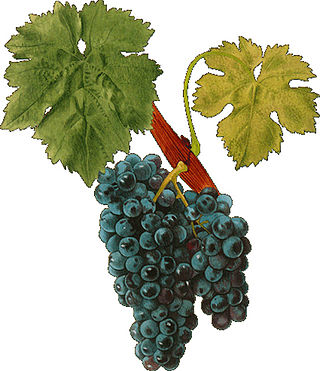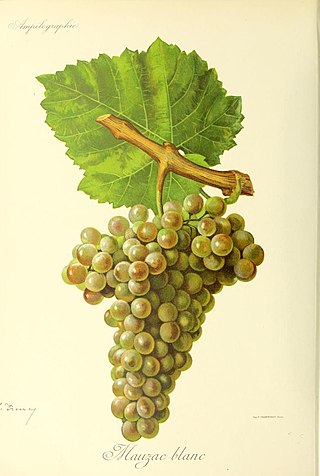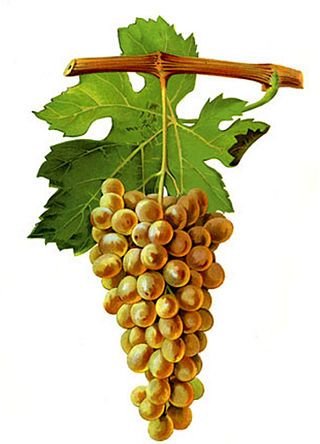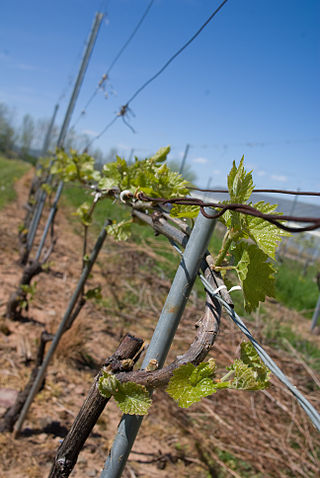
Carignan is a red grape variety of Spanish origin that is more commonly found in French wine but is widely planted throughout the western Mediterranean and around the globe. Along with Aramon, it was considered one of the main grapes responsible for France's wine lake and was a substantial producer in jug wine production in California's Central Valley but in recent years, it has been reborn as a flagship wine for many cellars in the south of France as well as in Catalonia.

Mauzac or Mauzac blanc is a white variety of grape used for wine, of the species Vitis vinifera. It is mainly grown in the Gaillac and Limoux regions in southwest France. Total French plantations of Mauzac stood at 3,200 hectares in the year 2000.
Crouchen is a white South African and Australian wine grape variety that originated in the western Pyrenees of France but is now virtually extinct in France due to its high susceptibility to fungal diseases like powdery and downy mildew. The grape is known under a wide variety of synonyms including Clare Riesling and Cape Riesling though it is not related to the well known international variety Riesling. Recent European Union regulation aimed at standardizing wine labelling laws has encouraged wineries to move away from these synonyms but their use still persists.

Tibouren or Rossese di Dolceacqua is a red French wine grape variety that is primarily grown in Provence and Liguria but originated in Greece and possibly even the Middle East. Intensely aromatic, with an earthy bouquet that wine expert Jancis Robinson describes as garrigue, Tibouren is often used in the production of rosés.
Couderc noir is a red wine hybrid grape that was formerly grown primarily in the South West France wine region and around the Gard département in the Languedoc-Roussillon region. The vine produces high yields and ripens late, creating a wine that is deeply colored with a distinct, earthy flavor. Couderc noir is normally used for mass commercial and table wines.
Courbu is the name of three different, but related varieties of wine grapes primarily found in South West France. All are Vitis vinifera grapes. The name Courbu, without suffix, can refer to both Petit Courbu and Courbu blanc, and not all sources differ between the two.

Txakoli de Álava (Basque) or Chacolí de Álava (Spanish) is a Spanish Denominación de Origen Protegida (DOP) for wines, located around the towns of Amurrio, Llodio, Artziniega, Okondo and Aiara in the province of Álava, Basque Country, Spain.

Txakoli de Getaria - Getariako Txakolina is a Spanish Denominación de Origen Protegida (DOP) for wines, located around the towns of Getaria and Zarautz, small fishing towns on the coast of the Bay of Biscay, in the province of Gipuzkoa, Basque Country, Spain. A small amount of grapes are also grown around the town of Aia.
Biancame is a white Italian wine grape variety that is grown in the Marche and Emilia-Romagna regions of Italy. Here it is an important component in the Denominazione di origine controllata (DOC) wines of Bianchello del Metauro and Colli di Rimini.

Incrocio Manzoni or Manzoni grapes is a family of grape varieties named after Professor Luigi Manzoni (1888-1968) of Italy's oldest school of oenology located in Conegliano, in the Veneto region. Manzoni created the new grape varieties by selecting, crossing and grafting vines from various vineyards during the 1920s and 1930s. The family includes both white and red grape varieties. Although most Manzonis are grown in northeastern Italy, they are mainly grown in the Piave area of Province of Treviso and are only now starting to be sold commercially in Europe and the United States.

Bianca is a white Hungarian wine grape variety that was developed in 1963 in the Eger wine region of northeast Hungary. The grape is a hybrid crossing of Bouvier and Eger 2. The grape was officially register for use in wine production in 1982 and today is used to make a wide assortment of wines from dry varietals to sweet dessert wines. Bianca is growing in popularity among organic vineyards due to its natural high resistance to many fungal diseases that affect grapevines.

Verdesse is a white French wine grape variety grown primarily in the Bugey AOC of eastern France. It is also permitted under the Vin de Savoie AOC for wines produced in the Isère department up to a maximum allowance of 10%. Ampelographers believe that the variety is likely very old and originated along the Drac and Grésivaudan valleys in Isère.
Landot noir is a red hybrid grape variety that is a crossing of Landal and Villard blanc. Created after a series of trials between 1929-1949, the grape was introduced to Canada and the United States in the 1950s and today can be found in Quebec as well as New Hampshire where a varietal is produced by Jewell Towne Vineyards.
Ravat blanc is a white hybrid grape variety that is a crossing of Chardonnay and a Seibel grape. While the Vitis International Variety Catalogue (VIVC) maintained by the Geilweilerhof Institute for Grape Breeding lists Seibel 5474 as the second parent, Master of Wine Jancis Robinson notes that other authors list Seibel 8724 as the parent. The grape is often confused with the white hybrid grape Vignoles that is often called just Ravat.
Cabernet blanc is a white German and Swiss wine grape variety that is a crossing of the French wine grape Cabernet Sauvignon and the hybrid grape Regent. The grape was bred by Swiss grape breeder Valentin Blattner in 1991. Cabernet blanc has strong resistance to most grape disease including botrytis bunch rot, downy and powdery mildew and tends to produce loose clusters of small, thick-skinned grape berries which can hang on the vine late into the harvest season to produce dessert wines. Today the grape is found primarily in the Palatinate wine region of Germany with some experimental plantings in Spain and the Netherlands. In France, in the Languedoc, Domaine La Colombette is heavily investing in PIWI grapes. Amongst others the Cabernet Blanc in their cuvée "Au Creux du Nid", is gaining wide acclaim.

Muscat bleu is a red Swiss wine and table grape variety that is a hybrid of Garnier 15-6 and Perle noire. The grape was developed in Peissy in the Canton of Geneva by Swiss grape breeder Charles Garnier in the 1930s. Today the grape is used as both a table grape and for winemaking, producing wines that Master of Wine Jancis Robinson describe as "soft and grapey". Outside Switzerland, some plantings of Muscat bleu can also be found in Belgium.

L'Acadie blanc is a white Canadian wine grape variety that is a hybrid crossing of Cascade and Seyve-Villard 14-287. The grape was created in 1953 by grape breeder Ollie A. Bradt in Niagara, Ontario at the Vineland Horticultural Research Station, which is now the Vineland Research and Innovation Centre. Today the grape is widely planted in Nova Scotia with some plantings in Quebec and Ontario. Some wine writers, including those at Appellation America, consider L'Acadie blanc as "Nova Scotia’s equivalent to Chardonnay".
Termarina rossa is a red Italian wine grape variety that is grown in the Emilia-Romagna region of northern Italy. The grape is unique among Vitis vinifera varieties in that it is naturally seedless. Historically Termarina rossa was grown in the provinces of Parma and Reggio Emilia for use in production of jams and saba, a sweet syrup, made from boiling the must but today it is used as a blending variety in some of Indicazione geografica tipica (IGT) wines of the area.
Albanella is a white Italian wine grape variety that is grown in the Marche region where it is a primary component in the white Denominazione di Origine Controllata (DOC) wines of Colli Pesaresi. The grape is often confused with the similarly named Sicilian wine grape Albanello and was long thought to be identical to the Tuscan wine grape Trebbiano but has established through DNA analysis to be its own distinct variety.










